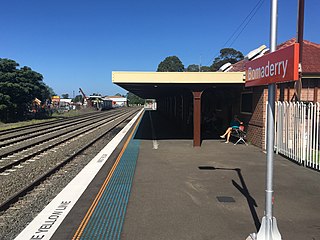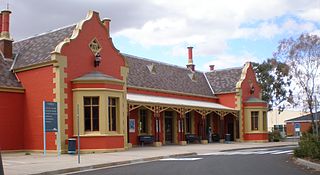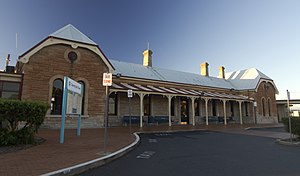
Dubbo is a city in the Orana Region of New South Wales, Australia. It is the largest population centre in the Orana region, with a population of 43,516 at June 2021.

Cobar is a town in central western New South Wales, Australia whose economy is based mainly upon base metals and gold mining. The town is 712 km (442 mi) by road northwest of the state capital, Sydney. It is at the crossroads of the Kidman Way and Barrier Highway. The town and the local government area, the Cobar Shire, are on the eastern edge of the outback. At the 2016 census, the town of Cobar had a population of 3,990. The Shire has a population of approximately 4,700 and an area of 44,065 square kilometres (17,014 sq mi).

Richmond railway station is the heritage-listed terminus railway station of the Richmond line, serving the Sydney suburb of Richmond, in New South Wales, Australia. It is served by Sydney Trains T1 Western and T5 Cumberland line services. It was added to the New South Wales State Heritage Register on 2 April 1999.

Dunmore railway station is a heritage-listed former railway station that was located on the South Coast railway line in Dunmore, City of Shellharbour, New South Wales, Australia. The station served the southern Wollongong suburb of Dunmore and indirectly Shellharbour and opened on 9 November 1887. The weatherboard station on Platform 2 dates from 1887. It is also known as the Shellharbour Railway Station Group, Shellharbour railway station and Dunmore Railway Station. The property was added to the New South Wales State Heritage Register on 2 April 1999.

Albion Park railway station is a heritage-listed railway station located on the South Coast railway line on the Princes Highway in Albion Park Rail, New South Wales, Australia. The station was designed by New South Wales Government Railways and built during 1887 by William Monie & Company, with the single line railway line built by David Proudfoot and Thomas Logan. The complex is also known as the Albion Park Railway Station Group. The property was added to the New South Wales State Heritage Register on 2 April 1999. The station is located close to Shellharbour Airport.

Berry railway station is a heritage-listed single-platform intercity train station located in Berry, New South Wales, Australia, on the South Coast railway line. The station serves NSW TrainLink diesel multiple unit trains travelling south to Bomaderry and north to Kiama. Early morning and late night services to the station are provided by train replacement bus services. In the past, the station precinct also catered to freight trains carrying cattle and dairy products.

Bomaderry railway station is a heritage-listed single-platform intercity train station located in Bomaderry, New South Wales, Australia, on the South Coast railway line. The station serves NSW TrainLink diesel multiple unit trains to Kiama. Early morning and late night services to the station are provided by train replacement bus services. A siding near the station is used by freight trains operated by the Manildra Group.

Goulburn railway station is a heritage-listed railway station on the Main Southern line in New South Wales, Australia. Opened on 19 May 1869, it serves the city of Goulburn. It was added to the New South Wales State Heritage Register on 2 April 1999.

Katoomba railway station is a heritage-listed railway station located on the Main Western line in Katoomba, New South Wales, Australia. It serves the Blue Mountains town of Katoomba opening on 2 February 1874 as Crushers, being renamed Katoomba on 9 July 1877.

Bathurst railway station is a heritage-listed railway station at Havannah Street, Bathurst, Bathurst Region, New South Wales, Australia. It is situated on the Main Western line and serves the city of Bathurst. It was added to the New South Wales State Heritage Register on 2 April 1999.
The Main Western Railway is a major railway in New South Wales, Australia. It runs through the Blue Mountains, and Central West regions. It is 825 kilometres (513 mi) with 484 kilometres (301 mi) operational & 341 kilometres (212 mi) under construction & repairs.

Molong railway station is a heritage-listed former railway station and now library on the Main Western railway line at Molong, Cabonne Shire, New South Wales, Australia. The property was added to the New South Wales State Heritage Register on 2 April 1999.

Orange railway station is a heritage-listed former railway bridge and now railway station located on the Main Western line on Peisley Street, Orange in the City of Orange local government area of New South Wales, Australia. It was built from 1877 to 1950. It is also known as Orange Railway Station and yard group. The property was added to the New South Wales State Heritage Register on 2 April 1999.

The 600/700 class railcars were a class of diesel multiple unit built by the New South Wales Government Railways. They were built to operate on branch lines from 1949 with low traffic volumes later being transferred to Newcastle and Wollongong to operate suburban services until withdrawn in 1994. However, one 600 class railcar was converted to solar operation for use on the Byron Bay Train service. The upgraded train entered service on 16 December 2017 and is believed to be the world's first solar-powered train.

The Far West Express was an Australian passenger train operated by the New South Wales Government Railways from December 1957 until September 1975 from Dubbo to Bourke, Cobar and Coonamble.
The Western Mail was an Australian passenger train that ran from Sydney to Dubbo and Parkes from 1973 until November 1988.

Tarana railway station is a heritage-listed railway station located on the Main Western line in Tarana, City of Lithgow, New South Wales, Australia. It is also known as the Tarana Railway Station and yard group. The property was added to the New South Wales State Heritage Register on 2 April 1999.

Stuart Town railway station is a heritage-listed railway station located on the Main Western line in Stuart Town in the Dubbo Regional Council local government area of New South Wales, Australia. The station serves the town of Stuart Town and opened on 1 June 1880 when the line was extended from Orange to Wellington. It became an unstaffed station on 10 April 1976. The station is also known as Stuart Town Railway Station group. The station was added to the New South Wales State Heritage Register on 2 April 1999.

Narrandera railway station is a heritage-listed railway station located at Whitton Street, Narrandera, Narrandera Shire, New South Wales, Australia. It is situated on the Hay railway line, and was formerly the junction station for the Tocumwal railway line. It was built in 1880 by Charles Hardy to a design attributed to John Whitton. The property was added to the New South Wales State Heritage Register on 2 April 1999.

Bourke railway station is a heritage-listed disused railway station and present coach terminal in Bourke, in the Far West region of New South Wales.




















